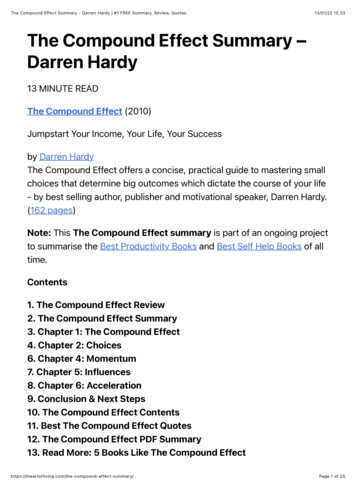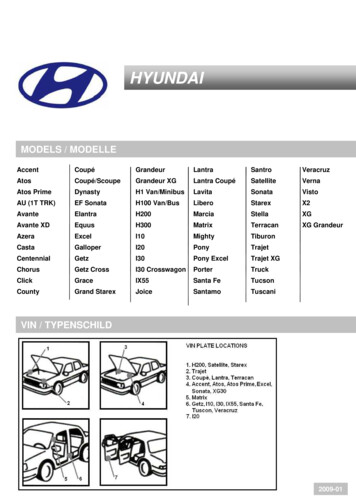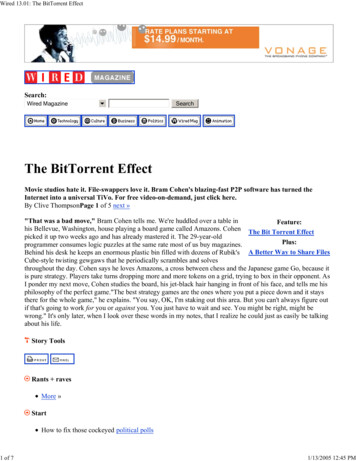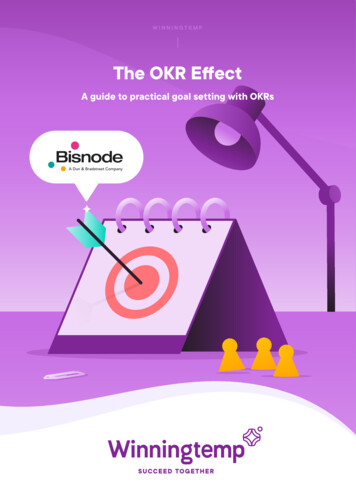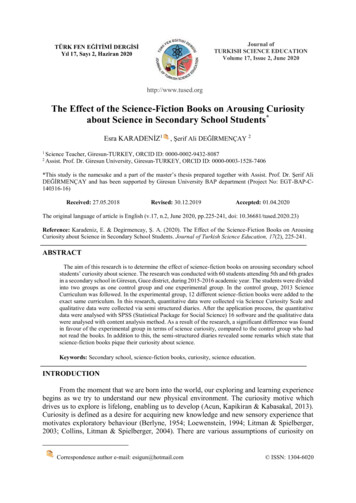
Transcription
Karadeniz, E. & Degirmencay S.A. 2020). The Effect of the Science-Fiction Journal ofTURKISH SCIENCE EDUCATIONVolume 17, Issue 2, June 2020TÜRK FEN EĞİTİMİ DERGİSİYıl 17, Sayı 2, Haziran 2020http://www.tused.orgThe Effect of the Science-Fiction Books on Arousing Curiosityabout Science in Secondary School Students*Esra KARADENİZ112, Şerif Ali DEĞİRMENÇAY 2 Science Teacher, Giresun-TURKEY, ORCID ID: 0000-0002-9432-8087Assist. Prof. Dr. Giresun University, Giresun-TURKEY, ORCID ID: 0000-0003-1528-7406*This study is the namesake and a part of the master’s thesis prepared together with Assist. Prof. Dr. Şerif AliDEĞİRMENÇAY and has been supported by Giresun University BAP department (Project No: EGT-BAP-C140316-16)Received: 27.05.2018Revised: 30.12.2019Accepted: 01.04.2020The original language of article is English (v.17, n.2, June 2020, pp.225-241, doi: 10.36681/tused.2020.23)Reference: Karadeniz, E. & Degirmencay, Ş. A. (2020). The Effect of the Science-Fiction Books on ArousingCuriosity about Science in Secondary School Students. Journal of Turkish Science Education, 17(2), 225-241.ABSTRACTThe aim of this research is to determine the effect of science-fiction books on arousing secondary schoolstudents’ curiosity about science. The research was conducted with 60 students attending 5th and 6th gradesin a secondary school in Giresun, Guce district, during 2015-2016 academic year. The students were dividedinto two groups as one control group and one experimental group. In the control group, 2013 ScienceCurriculum was followed. In the experimental group, 12 different science-fiction books were added to theexact same curriculum. In this research, quantitative data were collected via Science Curiosity Scale andqualitative data were collected via semi structured diaries. After the application process, the quantitativedata were analysed with SPSS (Statistical Package for Social Science) 16 software and the qualitative datawere analysed with content analysis method. As a result of the research, a significant difference was foundin favour of the experimental group in terms of science curiosity, compared to the control group who hadnot read the books. In addition to this, the semi-structured diaries revealed some remarks which state thatscience-fiction books pique their curiosity about science.Keywords: Secondary school, science-fiction books, curiosity, science education.INTRODUCTIONFrom the moment that we are born into the world, our exploring and learning experiencebegins as we try to understand our new physical environment. The curiosity motive whichdrives us to explore is lifelong, enabling us to develop (Acun, Kapikiran & Kabasakal, 2013).Curiosity is defined as a desire for acquiring new knowledge and new sensory experience thatmotivates exploratory behaviour (Berlyne, 1954; Loewenstein, 1994; Litman & Spielberger,2003; Collins, Litman & Spielberger, 2004). There are various assumptions of curiosity on Correspondence author e-mail: esigun@hotmail.com ISSN: 1304-6020225
226Journal of Turkish Science Education. 17(2), 225-241whether it is acquired or is an innate motive that potentially exists in an individual. However, arather recent study on the body of literature on Psychology would show that human curiosity isregarded as innate (Demirel & Coskun 2009).When the body of literature on the concept of curiosity is examined, Berlyne’s theory ofcuriosity appears to be widely accepted (Reio, 1997; Unal, 2005). Berlyne’s theory defines twokinds of curiosity: perceptual and epistemic. Perceptual curiosity is firstly aroused by new,complicated, eccentric, suspicious or confusing stimulus models (stated as ‘collative variables’in the sources). These stimuli then evoke a perceptual conflict or uncertainty which leads theindividual to compare the knowledge acquired through sense organs and initiates explorativebehaviour (Reio, 1997). Epistemic curiosity, on the other hand, includes the testing of questionsand prepositions which are triggered by conceptual uncertainty or complex ideas (theories ofknowledge, cognitive puzzles etc.) and intend to acquire the correct knowledge (Berlyne, 1954).Children are most curious and investigative when they are 6-14 years old. An examinationon this age range would prove that they are curious about science most and their questions arevastly on scientific subjects (Gurdal, 1992). Teachers, therefore, have a big responsibility tomaintain students’ relevant curiosity and investigative ambitions. For it is due to the efforts ofsearching, questioning, exploring and curious imaginative individuals with a strong ability ofinterpretation that any progress in the field of science would be possible (Eke, 2010).Science as a school subject consists of several topics and concepts which include variousdisciplines such as physics, chemistry, biology, and technology. Consequently, the term sciencemay appear as a set of complicated, abstract, and insolvable topics in many students’ minds.The students with such state of mind may not hold the desired levels of knowledge; readiness;general state of arousal; interest in, approach to and motivation for the topic at hand and theymight even lack the curiosity about science which is one of the significant triggers for learningin science education. Therefore, various methods and techniques should be employed so thatstudents like the subject, have fun while learning it and feel more curious about it (YilmazKorkut & Sasmaz Oren, 2018). In this sense, children’s books are quite useful.Children’s books are the fastest path to be suggested to familiarize with the reality ofhuman and life and develop a certain amount of sensitivity (Akal, 2006). According to Huck,Hepler, Hickman and Kiefer (1997), children’s books have benefits such as providing childrenwith a chance to have fun and joy while learning; enhancing their inner world; enabling themto establish a natural bond between their own lives and what they read; offering them anopportunity to meet with new and different life experiences (Kaya, 2006). Thus, science-fictionbooks are one sort of the children’s books that would both increase the students’ curiosity aboutscience and improve their creativity while providing them with a critical point of view.With their storytelling, science fiction books urge the reader to be creative (Sudaryat,Nurhadi & Rahma, 2019). In these books, new scientific and technical inventions, assumptions,or some contemporary facts are developed in imaginary ways and narrated accordingly (Karatas& Firat, 2006). Ekem (1990a) stated properties of science-fiction movies as “scientific content,future as a theme, suggestions about the future of technological products, discussion on theconcepts of good and evil, appealing to the individual’s imagination” are also applicable toscience-fiction books. Yet, in addition to demonstrate how far people’s imagination mightreach, these books have a prominent role in enlightening people and preparing them for thefuture (Ismihan, 2005). Because, a child who meets with different worlds in the science-fictionbooks can analyse the real world more easily (Balta, 2014).Science-fiction books can provide the child with knowledge while offering enjoyablefictions. This fantasy-based genre presents the knowledge to the children in a way that is notauthoritative, does not simplify the subject, or underestimates the child, contains educative andinstructive elements and transmits its message so clear that every age group can easily deduceit from the context within a playful fictionality (Karatas & Firat, 2006). Therefore, the
Karadeniz, E. & Degirmencay S.A. 2020). The Effect of the Science-Fiction instructive and educative function of science-fiction books can be utilized in science education.Yet, since science-fiction stories include practice of science, they can be effective on students’attitude towards science and they can serve as a useful means of instruction in developingpositive attitude towards science among students (Arikan & Demirbas, 2006).Science-fiction, above all, starts and resumes its topics on a scientific line. Thus, it has todiscuss many scientific facts. We can see that unreal knowledge is also presented along withreal scientific law as the facts are discussed in science-fiction works (Ekem, 1992). Nonetheless,science-fiction is still eligible as a means of education. While using science-fiction books forscience education, what we need to pay attention to is that, the students should not possess anyconceptual fallacies. After all, science-fiction books are not science books. The sole purpose ofutilizing them is to make science enjoyable and deliver knowledge and learning by adding somefun to the process.In view of the findings of the studies on utilizing science-fiction in science education(Ekem, 1990b; Cavanaugh & Cavanaugh, 1996; Fraknoi, 2003; Acar, 2003; Ongel Erdal,Sonmez & Day, 2004; Barnett, Wagner, Gatling, Anderson, Houle & Kafka, 2006; Bixler,2007; Yazici & Altiparmak, 2010; Laprise & Winrich, 2010; Surmeli, 2012; Lin, Tsai, Chien,& Chang, 2013; Orcan, 2013; Tang, 2014; Orcan & Kandil Ingec, 2016; Ozturk Onen, 2017)the benefits of using science-fiction in teaching science as a school subject can be summarizedas: It enhances scientific curiosity, enables the scientific content to be comprehended, It promotes a positive attitude towards science and technology, improves success in thefield of science, It visualizes abstract topics, provides scientific thinking, improves creativity, It enables scientific literacy, motivates students to gain scientific knowledge, It improves the relationship between scientific disciplines, encourages the students toexplain scientific concepts, It gives the students an understanding of scientific and technological ethics during thescientific process.As a result, with the adventures, times and places yet-to-be lived, science-fiction bookswould attract children’s attention (Balta, 2014), arouse their curiosity about science, encouragethem to read, do research, ask questions, think the answers over and to explore the relationshipbetween the pieces of knowledge. Thus, these books would take the students one step closer tobecome science literate individuals which is the eventual objective of science education. In theresearch that we have conducted for this purpose, the effect of science-fiction books on arousingcuriosity about science among secondary school students has been examined and answers havebeen sought to the following questions:1. Do the pre-test scores and post-test scores of Science Curiosity Test, that applied toexperimental group and control group consisting respectively of the students who readscience-fiction books and the students who did not, show a significant differencebetween the groups?2. Do the Science Curiosity Test scores of the students in experimental group and controlgroup show a significant difference between the pre-test and post-test applications onthe groups?3. Do the Science Curiosity Test scores of the students in experiment groups differsignificantly according to the students’ grade?4. In view of the content analysis of the diaries, what science concepts arouse the mostcuriosity in the students?227
228Journal of Turkish Science Education. 17(2), 225-241METHODSThe aim of this research is to determine to what degree the science-fiction books arouse5 and 6th grade students’ curiosity about science. Accordingly, the experimental group pre-test– post-test is used in this experimental design study. Thus, the dependent variable is measuredusing the same instrument both before and after the experiment. During the application, theeffect is given to the experimental group to be tested and not to the control group (Buyukozturk,Kilic Cakmak, Akgun, Karadeniz & Demirel, 2012). The processes performed for theexperiment group and the control group during the study are summarized in Table 1.thTable 1. Research designExperimental GroupControl GroupBefore theExperiment(Pre-Test)Experimental ProcessScience CuriosityTestBefore theOperation(Pre-Test)Science CuriosityTestAfter theExperiment(Post-Test)Teaching the science lessonaccording to the plan Reading 12 science fiction booksScience CuriosityTestDuring the OperationAfter the Operation(Post- Test)Teaching the science lessonaccording to the planScience CuriosityTesta) ParticipantsThe population of the research is composed of all the students who studied in the BoardingRegional Middle School in Giresun during 2015-2016 academic year. Sampling group includes60 students in 5th and 6th grades in Zubeyde Hanim Boarding Regional Middle School. Theinformation about experimental and control groups is given in the Table 2.Table 2. Sampling related dataGroupsGradelevelThe number offemale studentsThe number ofmale studentsTotalGrandtotalExperimental l group1530b) Data Collection ToolsIn this study, "Science Curiosity Scale” which was developed by Harty and Beall (1984)and translated into Turkish by Serin (2010) is used in order to collect quantitative data. Thestudents are asked to keep diaries and these semi-structured diaries are used in order to collectqualitative data.Science Curiosity ScaleIn this study, by using "Science Curiosity Scale", it is aimed to determine whether therehas been any change in the experimental group and the control group students’ science curiosity
Karadeniz, E. & Degirmencay S.A. 2020). The Effect of the Science-Fiction levels measured at the beginning of the application, through the end of the application. For theresearch, Science Curiosity Scale that was developed by Harty and Beall (1984) and translatedinto Turkish by Serin (2010) is used. The original name of the scale is "Children's ScienceCuriosity Scale". It is a 5-point Likert scale consisting of total 30 items, 8 of which are negative.The scale is based on four factors. These are novelty, lack of clarity, complexity of stimuli,surprise/bafflement.The Cronbach’s α reliability coefficient for the English version of the scale was measuredto be 0.85. That of the Turkish version of the scale was measured to be 0.87 (Serin, 2010). Asfor this research, Cronbach α reliability coefficient is measured to be 0.81 in the studyconducted with a total of 100 students in 5th grade and 6th grade. In the field of education andsocial sciences, this reliability coefficient of 0.81 is regarded as a highly reliable scale.Semi-Structured DiariesIn this research, the students are asked to keep a diary in the course of the reading processand write down their opinions about each book they finished reading. Since we cannot be surewhether the students answer the "Science Curiosity Scale" questions with full comprehensionor not, these diaries are used in order to make them spell out what they hold in their minds. Thesemi structured diary consists of 6 questions. First 4 questions consist of “collative variables”(novelty, lack of clarity, complexity of stimulus, surprise) which are also the elements of"Science Curiosity Scale" and the stimuli of perceptual curiosity; the 5th question is aboutscience curiosity and the 6th is related to the evaluation of the book in terms of science, and tothe process itself.The researcher ensured the reliability and validity of the questions bytaking the required expert opinion.Table 3. Questions about students’ diary about reading books1) Did you come across with new or unusual things in the book you have read? Explain briefly.2) Did you come across with any pointless, uncertain situation in the book you have read? Explain briefly.3) Did you come across with any situation that you found complex, confusing in the book you have read?Explain briefly.4) Did you come across any situation that surprised you in the book you have read? Explain briefly.5) Are there any situations or events that increase your curiosity about science in the book you have read?Explain briefly.6) How do you like the book in the context of science? Briefly describe your thoughts about the book.c) The Process of Selecting the Science Fiction BooksAt first stage of the study, the books to be employed in the research have been selected.This selection is done according to the following criteria:1. It should be written by a well-known author;2. It should be a scientific book;3. It should be appropriate to the age-group level of the students;4. It should be funny and informative;5. It should be recommended by the performing experts in the field of children'sliterature.By considering these criteria, 9 science fiction children's books are selected. In addition,3 non-science fiction books alternating the genre (Catalhoyuk Stories Series: First Dawn ofOur World, Children of Fire, Abundance and War) have also been selected as they fictionalizethe past anew. As a result, the students have read 12 books in total.229
230Journal of Turkish Science Education. 17(2), 225-241Table 4. The Names and authors of science fiction books that have been read by theexperimental group 1234Name of the BookFrom the Earth to the MoonTwenty Thousand Leagues Underthe SeaJourney to the Center of the EarthJourney to Mars at the Speed ofLightAuthor Jules VERNE7Time AccidentBilgin ADALIJules VERNE8Cipher of GenesBilgin ADALIJules VERNE9Aliens Are ComingBilgin ADALIAydoganYAVASLI10Name of the BookThe First Dawn of OurWorldAuthorBilgin ADALI5Time BikeBilgin ADALI11Children of FireBilgin ADALI6Guests from the PastBilgin ADALI12Abundance and WarBilgin ADALId) Data AnalysisAs a non-parametric analysis method, Mann Whitney U Test; and as a parametric analysismethod, Paired Samples T-Test have been applied in order to determine whether theexperimental group and the control group differ in terms of science curiosity score or not. Inaddition, two-way ANOVA is used in order to determine if the pre-and post-practice sciencecuriosity scores would show any significant difference according to the grade level. The twoway ANOVA is used for repeated measures on a single factor (Buyukozturk, 2012).In Likert-type Scientific Curiosity Scale consisting of 30 items, 5 options have beenoffered for each item. These are "absolutely agree", "agree", "indecisive", "disagree" and"strongly disagree". These options were given the points 5, 4, 3, 2, 1 respectively. There are 8negative items on the scale. These have been scored vice versa. The highest possible score forthe test is 150 points and the students, whose score were close to this, proved to be very curiousabout science. The lowest possible score is 30 and the students whose score were close to thisproved little interest in science (Serin, 2010). The level of significance (p) is generally taken as0.05 when in analysing the research findings.Semi-structured dairies have been analysed via ‘content analysis’ which is one of thequalitative research methods. The content analysis defines the data and reveals the facts hiddenwithin the data. In other words, it reaches the concepts and correlations that could revealcollected data (Yildirim & Simsek, 2016). The qualitative data in this research are composedof the students’ opinions about 12 different science fiction books. The data obtained from thesemi-structured diaries have been coded by content analysis and the themes are determinedaccordingly. The themes obtained from every diary include extra-terrestrials, celestial bodies,space vehicles, force, density, biodiversity, environmental problems, genetics, reproduction,light, electricity, simple machines, layers of the Earth, fossils, elements, heat, food storageconditions, laboratory work, invention, and the personal characteristics and work discipline ofscientists.FINDINGSa) Findings Related to "Science Curiosity Scale"When the results obtained from the research were examined, the results of the MannWhitney U-test has been used in order to see if there is a significant difference between thescores that control and experimental groups achieved in preliminary test, and the findings aregiven in Table 5.
Karadeniz, E. & Degirmencay S.A. 2020). The Effect of the Science-Fiction Table 5. The SCS pre-test sequence averages and Mann-Whitney U-test results forexperimental and control groupsGroupsExperimentPre-testControlPre-test*p 0.05NMean RankRank ng to Table 5, there is a significant difference between the pre-test point averageof control group and that of experimental group (p 0.021; p 0.05). According to this result, itis obvious that before the science fiction books are read, the science curiosity scores of thestudents in each group are close to each other, and the groups are not homogenous. The meanrank suggests that, there is a difference in favour of the experimental group.For the students of the experimental group, in order to test if there were any differencebetween their scores of "Science Curiosity Test" which was applied both before and afterthey’ve read science-fiction books, Paired Samples T-Test has been used and the findings aregiven in Table 6.Table 6. Averages of the SCS pre-test and post-test scores of the experimental group and PairedSamples T-test resultsExperimentalGroupPre-testPost-test*p ding to Table 6, the point average of the students before the application is 1.22whereas it is 1.28 after the application. As a result, the average of the test scores is increasedby 0.06 points. This finding reveals that science-fiction books are effective in increasing sciencecuriosity. According to T-test results, there is a significant relationship between pre-test andpost-test of the experimental group (p 0.002; p 0.05). With reference to this, the increase inthe students’ science curiosity point average after they read the science-fiction books, is notaccidental but substantive.For the students of the control group, in order to test if there were any difference betweentheir scores of "Science Curiosity Test" which was applied both before and after the study,Paired Samples T-Test has been used and the findings are given in Table 7.Table 7. Averages of the SCS pre-test and post-test scores of the control group and PairedSamples T-test resultsControlGroupPre-testPost-test*p ding to Table 7, the point average of the students before the application is 1.13whereas it is 1.16 after the application. As a result of the application, the score average of thetest is increased by 0.03 points. This finding reveals that without science-fiction books, there isalso an increase in the point average of the science curiosity. However, according to T-testresults, there is no significant relationship between pre-test and post-test of the control group(p 0.204; p 0.05). This indicates that, the increase in the point average is accidental. In otherwords, there is no significant increase in the science curiosity point average of the students whodid not read science-fiction books.231
232Journal of Turkish Science Education. 17(2), 225-241In order to test whether the control group and the experimental group differ in their posttest scores or not, Mann Whitney U-Test results are employed and shown in Table 8.Table 8. The SCS post-test sequence averages and Mann-Whitney U-test results forexperimental and control p 0.05NMean RankRank SumUp*3036,951108.50256.00.0043024,05721.00As seen in Table 8, there is a significant difference between the final post-test sciencecuriosity point averages of control group and the experimental group (p 0,004; p 0.05). Whenthe mean rank is taken into consideration, it is determined that the final post-test point averageof the experimental group is higher. This finding indicates that reading science-fiction bookshas a positive effect on increasing the science curiosity.The findings related to the pre-test and post-test scores of the experimental group studentsaccording to their grade levels are given in Table 9.Table 9. According to grade levels, pre-test, and post-test statistics of the experimental groupExperimentalGroupGrade -testAs seen in Table 9, the 5th grade students' pre-test science curiosity point average is 1.22,while this value is 1.29 after the experiment. The pre-test science curiosity point average forgrade 6 students is 1.22, while this value is 1.27 after the test. Accordingly, there is an increasein the science curiosity point average of both 5th and 6th grade students who participated in theexperiment.In order to test whether the experimental group in grade level (5th and 6th grades) differin their pre-test and post-test scores or not, two-way ANOVA is used, and the findings areshown in Table 10.Table 10. Results of two-way ANOVA analysis of pre-test-post-test scores and grade levels inthe experimental groupSource ofVarianceSum roups*Grade Level*p 0.05As seen in Table 10, pre-and post-practice science curiosity scores do not differsignificantly in terms of the grade level (p 0.670; p 0.05). Accordingly, there is no grade
Karadeniz, E. & Degirmencay S.A. 2020). The Effect of the Science-Fiction level related difference between the pre and post experiment science curiosity scores of 5th and6th grade students, but there is a significant increase in post-experiment science curiosity scoresof the students in general (p 0.002; p 0.01) compared to the pre-experiment scores.b) Findings Related to Semi-Structured DiariesThe 30 students who participated in the research have been asked to write diaries about12 books that they read. At the end of each book, students wrote their own feelings and thoughtsin the context of the given questions about the book they read. So, 360 content analysis of thediaries were made. The data from the diaries have been tabulated to provide an easierexamination on the situations that increase students’ curiosity, and the findings have beenidentified by charts.Table 11. Findings from science fiction booksThe name of theBookFindingsA trip to the Moon, to try to go to the Moon by bullets, the size of the bulletas a vehicle for the trip and that of the barrel that would eject it, how the crewsurvive in the outer space are found to be the most remarkable parts of theFrom the Earth to thebook for the students. And 29 students stated that the book increased theirMoonscience curiosity. All students stated that the book was entirely about scienceand most of them said that it contained useful information.Twenty ThousandLeagues Under the SeaThe interiors and the structure of the submarine, the way it sinks and movesunder the sea, marine life and league as a unit of measurement are found to bethe most important parts of the book for the students. 26 students stated thatthe book increased their science curiosity. 29 students stated that the book wasentirely about science and most of them said that it contained usefulinformation. Yet, 1 student did not think the book was relevant to science.To try to reach the centre of the World, the interiors of volcanoes, andinformation about underground life are found to be the most interesting partsJourney to the Center ofof the book for the students. 29 students stated that the book increased theirthe Earthscience curiosity. All the students expressed that the book was entirely aboutscience and most of them said that the book contained useful information.Invention of Time Bicycle, to travel in time, continually inventing new thingsin order to make life easier, burning a fire without using a lighter are found tobe the most interesting parts of the book for the students. 27 students statedthat the book increased their science curiosity and that the book wasTime Bikecompletely related to science. 3 students stated that the book was partly relatedto science. And also, most of the students said that the book contained usefulinformation.Guests from the PastBenefits of innovations, the fact that Anin and Cuka referred to the new thingsthey saw for the first time as ‘magic’, future germs infecting people in thepast, changes in the past being effective on the future, how the mirror thatCuka took home with her affected the future are found to be the mostinteresting parts of the book for the students. 25 students stated that the bookincreased their science curiosity. 23 students said that the book was entirelyabout science, 4 students stated that the book was partly related to science and3 students noted that the book was not about science. Most of the students saidthat the book contained useful information.233
234Journal of Turkish Science Education. 17(2), 225-241Time AccidentCipher of GenesAliens Are ComingThe characters being trapped in time, activating the broken time machine bykicking it, inventing things that would make life easier are found to be themost interesting parts of the book for the students. 24 students stated that thebook increased their science curiosity. 29 students thought that it was totallyscience related, 1 student stated that the book was not related to science, mostof the students said that the book was exciting and curious.Genes, information contained within our genes, nuclear research laboratoryand Ilke’s dream about the past are found to be the most interesting parts ofthe book for the students. 28 students have found that the book increased theirscience curiosity. 21 students thought that the book was totally science relatedand 9 students stated that the book was partly related to science. Most of thestudents said that the book contained useful information.The existence of extra-terrestrials, the changes in animals due to nuclear leaks,extra-terrestrials asking for human beings’ help and using music notes as ameans of communication for this purpose a
future (Ismihan, 2005). Because, a child who meets with different worlds in the science-fiction books can analyse the real world more easily (Balta, 2014). Science-fiction books can provide the child with knowledge while offering enjoyable fictions. This fantasy-based genre presents the knowledge to the children in a way that is not







